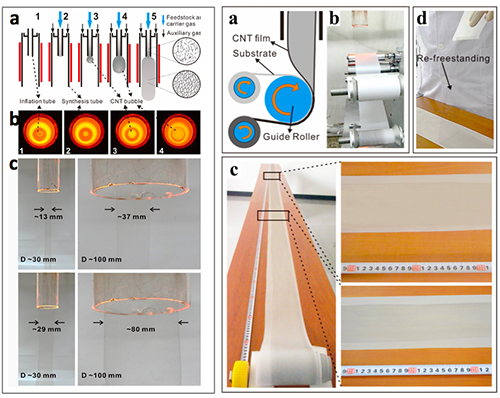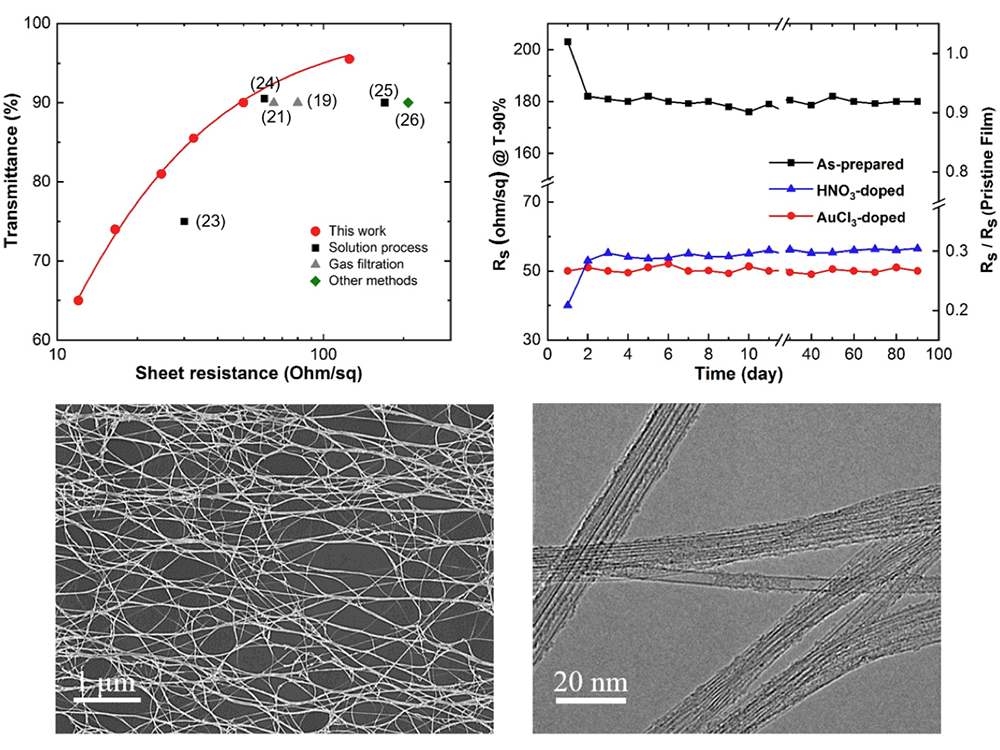Continuous Fabrication of Single-Walled Carbon Nanotube Transparent Conductive Films via Blown Aerosol Technique
Date:23-09-2020 Print
Transparent conductive electrodes have pervaded modern technologies since they represent an essential component of various optoelectronic devices. Currently, indium tin oxide (ITO) is the most widely used transparent conductive material. The brittle nature and the limited resource of indium, however, present many challenges for ITO applications in flexible electronics. Because of the outstanding electrical, optical, and mechanical properties, good flexibility, and high environmental stability, single-walled carbon nanotube (SWCNT) exhibits great potential among the candidates of flexible transparent conductive films (TCFs). Up till now, the main methods for production of SWCNT TCFs include liquid-phase processing and floating catalyst chemical vapor deposition (FCCVD).
The researchers in group A05 at Institute of Physics, Chinese Academy of Sciences, have focused on the investigations relating to preparations, properties and applications of carbon nanomaterials near 30 years. Recently, Dr. Qiang Zhang, Prof. Weiya Zhou, and Prof. Sishen Xie et al. have developed an innovative approach, Blown Aerosol Chemical Vapor Deposition (BACVD), to directly and continuously produce high-quality, freestanding, and transparent conductive SWCNT films with a yield of several hundred meters per hour. Both the carbon conversion efficiency and the SWCNT TCF yield with the BACVD could be three orders of magnitude higher than those with the conventional FCCVD.
BACVD is inspired by the extrusion blown plastic film technique and the CNT synthesis via FCCVD. Basically, this approach introduces the blown CNT aerosol technique into the FCCVD process of the CNT synthesis in a well-designed reactor. Systematic investigation reveals that two critical processes (C1 and C2) are involved in BACVD. In process C1, a stable aerosol bubble is blown, while in process C2 the bubble is transformed from an aerosol into an aerogel. Then the tubular CNT film is blown out from the outlet of the reactor. Furthermore, a general phase diagram composing of four regions was determined to predict and explain the synthesis mechanism of CNTs in BACVD. The film manifests a sheet resistance of 40 ohm/sq at 90% transmittance with doping, representing a good optoelectrical performance as a TCF. A setup has been designed for direct and continuous collection of the BACVD synthesized film, which is compatible with the general roll-to-roll process. The related work has been published on Advanced Materials (10.1002/adma.202004277). Prof. Esko Kauppinen from Aalto University provided valuable suggestions in the draft preparation. Besides CNT TCFs, we also studied CNT fibers with high strength and high conductivity based on BACVD. The continuous fibers were fabricated via shrinking tubular CNT films with liquid. Their performance can be dramatically improved with an acid treatment. Especially, the fibers' strength and electrical conductivity reach up to ~ 2 GPa and ~ 4.3 MS/m, respectively, with chlorosulfonic acid treatment.
BACVD will be of great significance for both academia and industry. This technique proposes a new assembly idea of CNT macrostructures-the CNT aerosol is fabricated into the target form by being solidified into an aerogel during nanotube growth. Moreover, the high carbon conversion efficiency and ultrahigh extrusion yield of BACVD are crucial for economical production of CNT as 'engineering materials', such as electrodes, TCFs, and fibers.
This work was financially supported by the National Key R&D Program of China (Grant No. 2018YFA0208402), the National Natural Science Foundation of China (11634014, 51172271, and 51372269), the "Strategic Priority Research Program" of the Chinese Academy of Sciences (XDA09040202), the National Basic Research Program of China (Grant No. 2012CB932302).

Figure 1. Fabrication and collection of a CNT film by BACVD

Figure 2. General phase diagram with 4 phase regions of BACVD (left), performance comparison of CNTs from various phase regions (middle), and CNT TCF yield and carbon conversion efficiency in BACVD (right).

Figure 3. Optical and electrical performance, stability, and micro morphology of CNT TCFs synthesized by BACVD.

Figure 4. Continuous preparation and morphologies of CNT fibers based on BACVD.


